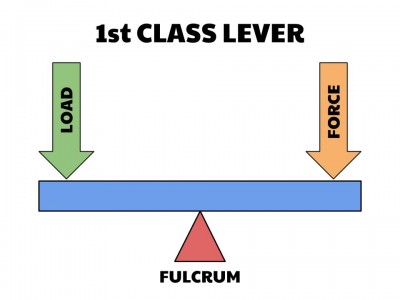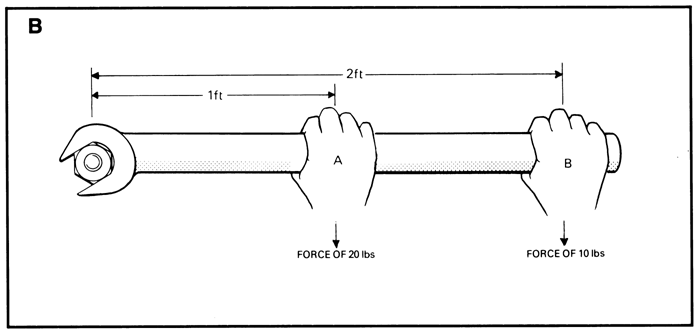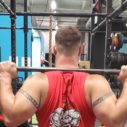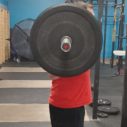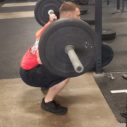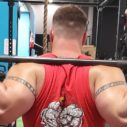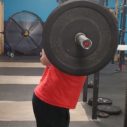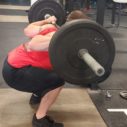Good Mornings & RDLs & Back Squats, Oh My!
by Erik Castiglione
In our training this week we had Romanian Deadlifts and Low Bar Back Squats, which prompted a couple questions from our members. The first question was “what’s the difference between a Romanian Deadlift and a Good Morning?” We frequently program both in our warm-ups, and they are sometimes used interchangeably, so this is an excellent question. The second question was “what’s the difference between a High Bar and Low Bar Back Squat?” Another good one. So, let’s dive in:
RDL vs. Good Morning
There are 6 foundational movement patterns: upper body push, upper body pull, squat (lower body push), hinge (lower body pull), lunge, and carry. Both RDLs and good mornings are examples of the hinge movement pattern. To understand the difference, we must first ask “What is a hinge?” It’s a bend at the hips while keeping the knees unlocked. Recall for a moment your basic high school physics, specifically levers. In a lever, the fulcrum is the point about which a lever rotates. In a hip hinge, your hips serve as the ONLY fulcrum. To ensure this, we must keep our low backs tight.
There are a couple ways we can illustrate this – let’s look at the videos below.
In the first video, I push my hips backwards behind me, so that my butt contacts the wall. This ensures that I do not bend at the waist. Perhaps a more helpful illustration is the second video. In my first attempt, I bend forward at the waist instead of the hips, resulting in my face planting in the wall (ouch). In attempts 2 and 3, I lock my low back and bend ONLY at the hips. Despite my feet not moving, I’m now able to lower my trunk without face planting.
Now that we understand what a hinge is, we can look at the difference between RDLs and good mornings. In an RDL, we hold the weight in front of us at our hips. When we hinge in this position, the bar travels in a mostly straight path, staying over our midline, as shown below.
In a Good Morning, we hold the weight higher up on our torso. In the case of a barbell good morning, the bar is on our back. (When using a sandbag or KB, we hug the weight to our chest). Hinging with weight in this position causes the bar to travel much farther forward from our midline than in an RDL, as you can see below.
What is the net effect? Going back to our physics discussion, let’s discuss torque. Torque is the measure of a force that can cause an object to rotate about its axis. It is equal to twisting motion that causes rotation, and it’s equal to force x length, where length is the distance away from the fulcrum point. The greater the distance, the greater the torque. To prevent torsion, greater force must be applied to counteract the torque.
When we put the bar on our back in a good morning, we’re increasing the distance from the fulcrum, resulting in greater torque. The muscles we use to resist this torque are our spinal erectors. So, the net effect is that we tax our lower back MORE in a good morning than we do in an RDL. While both work both the hamstrings and the low back, a good morning has more emphasis on the low back, and RDLs have more emphasis on the hamstrings. This also means that we can handle more weight in an RDL than in a good morning. Both have their uses, but it’s important to understand when it’s more appropriate to use one as opposed to the other.
Low Bar vs. High Bar
Moving on to question number 2, and again the answer comes down to bar position and the effect it has on the lift. Let’s look at a high bar squat first. In the high bar squat, the bar rests on the athlete’s traps, and the athlete stands straight at the top. At the bottom of the squat, the athlete has an upright torso.
In the low bar squat, the bar sits on top of the athlete’s shoulder blades. To keep the bar in position, the athlete is forced to lean forward slightly. This slightly forward position is maintained throughout the lift. Since we use our hamstrings to BOTH flex our knees AND extend our hips, this forward position allows for a little more slack in the hamstrings, which in turn allows us to recruit them more. Thus, the low bar position allows us to use more of our posterior.
Both squat variations have their uses, so we like to use both. That being said, not everyone is anatomically the same. We have different torso lengths, and leg proportions. For some people, one variation isn’t just preferable: it’s the only safe option. In these instances, we exclusively use the safe variation. For everyone else, you get to do both, even if you prefer one over the other.
So, in case you’re wondering why we use RDLs over good mornings, or low bar instead of high bar, or vice versa, now you know. And knowing is half the battle 😊

